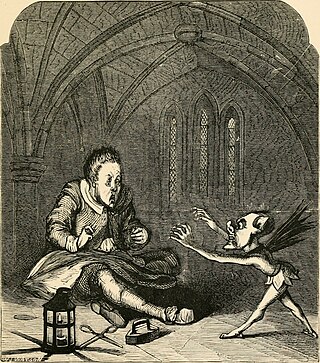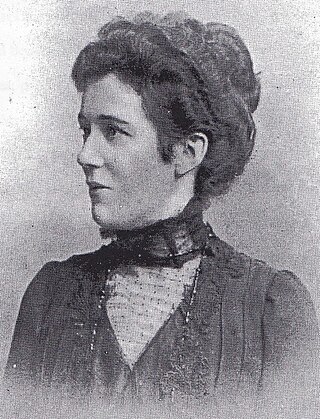
A fairy is a type of mythical being or legendary creature, generally described as anthropomorphic, found in the folklore of multiple European cultures, a form of spirit, often with metaphysical, supernatural, or preternatural qualities.

The púca, puca, also pwca, pookah, phouka, and puck, is a creature of Celtic, English, and Channel Islands folklore. Considered to be bringers both of good and bad fortune, they could help or hinder rural and marine communities. Púcaí can have dark or white fur or hair. The creatures were said to be shape-changers that could take the appearance of horses, goats, cats, dogs, and hares. They may also take a human form, which includes various animal features, such as animal ears or a tail.

A changeling, also historically referred to as an auf or oaf, is a human-like creature found throughout much of European folklore. According to folklore, a changeling was a substitute left by a supernatural being when kidnapping a human being. Sometimes the changeling was a 'stock', more often the changeling was a supernatural being made magically to look like the kidnapped human.

In Manx folklore, a buggane was a huge ogre-like creature native to the Isle of Man. Some have considered them akin to the Scandinavian troll.

Wren Day, or Hunt the Wren Day, is an Irish and Manx custom on 26 December, Saint Stephen's Day. Traditionally, men and boys hunted a wren, which was revered as the 'king of the birds'. They displayed it on top of a staff decorated with holly, ivy and ribbons, or in a decorated box on top of a pole. This was paraded around the neighbourhood by a group of 'Wrenboys'—typically dressed in straw masks, greenery and colourful motley clothing—who sang songs and played music in exchange for donations. This was meant to ensure prosperity for the coming year. Afterwards, the wren was buried. On the Isle of Man, they held a funeral for the wren and danced around a 'wren pole'.

The culture of the Isle of Man is influenced by its Celtic and, to a lesser extent, its Norse origins, though its close proximity to the United Kingdom, popularity as a UK tourist destination, and recent mass immigration by British migrant workers has meant that British influence has been dominant since the Revestment period. Recent revival campaigns have attempted to preserve the surviving vestiges of Manx culture after a long period of Anglicisation, and significant interest in the Manx language, history and musical tradition has been the result.

The each-uisge is a water spirit in Irish and Scottish folklore, spelled as the each-uisce in Ireland and cabbyl-ushtey on the Isle of Man. It usually takes the form of a horse, and is similar to the kelpie but far more vicious.
The leannán sídhe is a figure from Irish folklore. She is depicted as a beautiful woman of the Aos Sí who takes a human lover. Lovers of the leannán sídhe are said to live brief, though highly inspired, lives. The name comes from the Gaelic words for a sweetheart, lover, or concubine and the term for inhabitants of fairy mounds (fairy). While the leannán sídhe is most often depicted as a female fairy, there is at least one reference to a male leannán sídhe troubling a mortal woman.

Manx English, or Anglo-Manx, is the historic dialect of English spoken on the Isle of Man, though today in decline. It has many borrowings from Manx, a Goidelic language, and it differs widely from any other variety of English, including dialects from other areas in which Celtic languages are or were spoken, such as Welsh English and Hiberno-English.

Sophia Morrison was a Manx cultural activist, folklore collector and author. Through her own work and role in encouraging and enthusing others, she is considered to be one of the key figures of the Manx cultural revival. She is best remembered today for writing Manx Fairy Tales, published in 1911, although her greatest influence was as an activist for the revitalisation of Manx culture, particularly through her work with the Manx Language Society and its journal, Mannin, which she edited from 1913 until her death.
Fenodyree in the folklore of the Isle of Man, is a hairy supernatural creature, a sort of sprite or fairy, often carrying out chores to help humans, like the brownies of the larger areas of Scotland and England.

Glashtyn is a legendary creature from Manx folklore.
Mooinjer veggey is the Manx for little people, a term used for fairies in Gaelic lore. The equivalent Irish and Scottish Gaelic are Muintir Bheaga and Muinntir Bheaga.
Seelie is a term for fairies in Scottish folklore, appearing in the form of seely wights or The Seelie Court. The Northern and Middle English word seely, and the Scots form seilie, mean "happy", "lucky" or "blessed." Despite their name, the seelie folk of legend could be morally ambivalent and dangerous. Calling them "seelie," similar to names such as "good neighbors," may have been a euphemism to ward off their anger.
Arkan sonney is the Manx term for hedgehog. In Manx folklore it is a type of fairy animal that takes the form of a white pig that brings good fortune to those who manage to catch it. It was even considered a favourable omen just to have seen the "lucky piggy". It was also said that if you caught one you would always find a silver coin in your pocket. However, holding on to it for too long will result in bad fortune.

Tylwyth Teg is the most usual term in Wales for the mythological creatures corresponding to the fairy folk of Welsh and Irish folklore Aos Sí. Other names for them include Bendith y Mamau, Gwyllion and Ellyllon.
John Joseph Kneen was a Manx linguist and scholar renowned for his seminal works on Manx grammar and on the place names and personal names of the Isle of Man. He is also a significant Manx dialect playwright and translator of Manx poetry. He is commonly best known for his translation of the Manx National Anthem into Manx.

Fairy Bridge, Isle of Man is a small bridge over the Santon Burn in the Isle of Man, located on the primary A5 Port Erin to Douglas road, at grid reference 305720, on the parish boundary between Santon and Malew. A superstition associated with the Fairy Bridge is that passers-by must greet the fairies as they cross it; it is considered bad luck not to greet them.
Gwragedd Annwn, alternatively known as Dames of the Lower Region, Dames of Elfin Land, or Wives of the Lower World, are beautiful female fairies who live beneath lakes and rivers found in Welsh folklore. They are counted among the Tylwyth Teg or Welsh fairy folk.The mythological narrative of Gwragedd Annwn is intertwined with the origin of the Welsh black cattle. Some legends hold that the existence of the Gwragedd Annwn was owed to the famed Saint Patrick. Occasionally, the fairies were said to ascend into the upper world, and be visible to ordinary people.
Sleih beggey is the umbrella term for Manx fairies.











